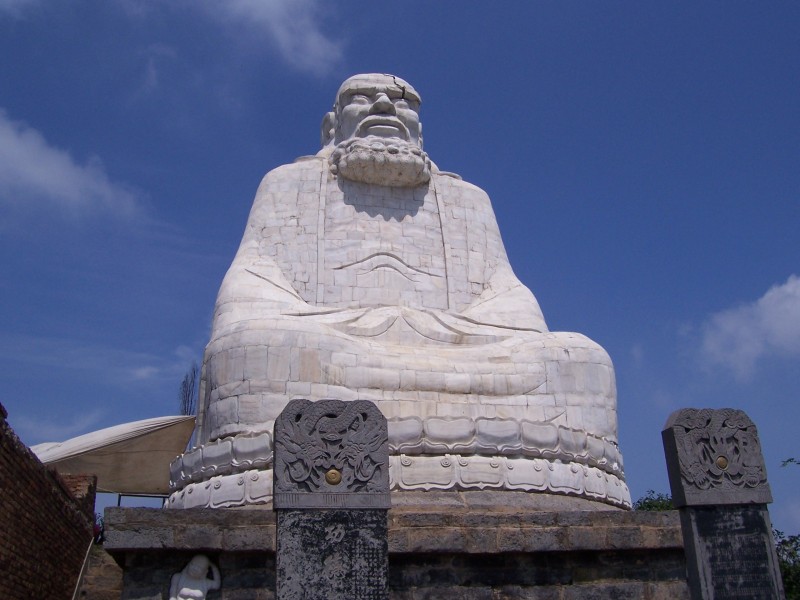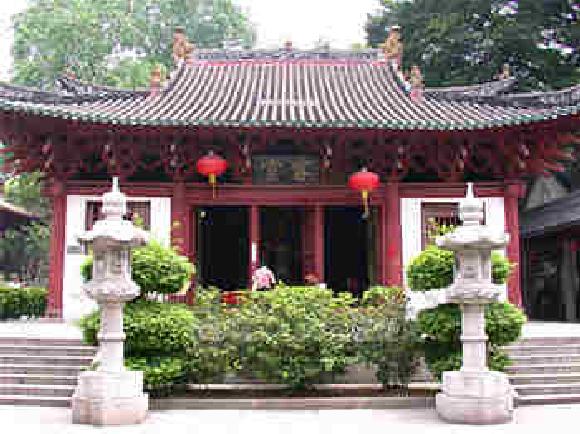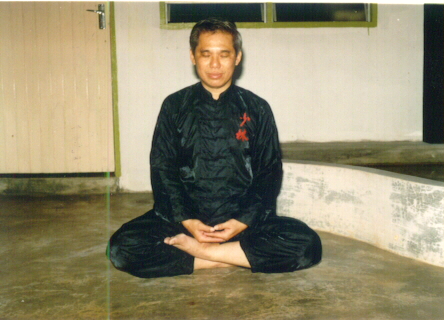July 2009 (Part 1)
SELECTION OF QUESTIONS AND ANSWERS

A modern statue of Bodhidharma in China, reproduced from http://www.trip-to-china.com/pic_shaolin_temple.html
Question 1
Sigung, a question about Zen came up in class with Sifu Anthony Korahais, and we decided that it would be a good question to ask you. Does Patriarch Zen train the skill of one-pointed mind? Or are Patriarch Zen and Tatagata Zen totally separate techniques?
— Arun, USA
Answer
Yes, Patriarch Zen trains the skill of one-pointed mind. On the other hand, Tatagata Zen also trains the skill of no mind. In other words, both Patriarch Zen and Tatagata Zen train both one-pointed mind and no mind, although the focus may be different.
Patriarch Zen and Tatagata Zen are two different techniques or apporoaches, but they are not totally separated. In fact they are closedly related.
There are countless techniques for meditation, but they may be classified into two main categories, namely to attain a one-pointed mind and to attain no mind, which actually means all mind. In mathematical terms, all meditation may be reduced to one or zero.
When one's mind is reduced to one, his mind becomes very sharp and focussed. When his mind is reduced to zero, at the phenomenal level he attains mental clarity, at the transcendental level he attains Zen, called variously by people of different cultures as returning to God, attaining the Tao or merging into Cosmic Reality.
A person's mind is full of thoughts all the time. By disciplining his mind through meditation he may reduce the countless thoughts to just one. There are many techniques to achieve this purpose, but all of them apply the principle of "using one thought to tame hundreds of thoughts". Some examples are focusing on the dan tian (or energy field), focusing on an external object like a pebble, focusing on one's breath, reciting a line of a scripture or reciting some meaningless sounds.
In Buddhist meditation the most famous technique is focusing on the breath. This was taught by the Buddha himself. When an aspirant can successfully focus on his breath to the exclusion of all other thoughts, his mind becomes one-pointed. This process is known as Concentration.
He then progresses to Contemplation. He uses his concentrated mind to contemplate on a chosen topic. In Buddhist meditation he may contemplate on his physical body or contemplate on life. With his one-pointed mind he investigates further and deeper into whether his body is real or what life really is.
Eventually he discovers experientially, not just intellectually, that his body, life or anything else is actually "empty". At earlier levels, this is a satori, a spiritual awakening. At the supreme level, this is Nirvana, or Enlightenment, called variously by people of different cultures as returning to God, attaining the Tao or merging with the Great Void.
This is the approach or tradition taught by the Buddha, and is used in most Buddhist traditions. Hence it is called Tatagatha Zen. "Tatagatha", a Sanskrit word meaning "thusness" or "everything there is", is a title addressed to the Buddha. Most other spiritual disciplines also use this approach.
Tatagatha Zen takes a long time, often many life-times. In Zen Buddhism, an aspirant aims to attain Enlightenment here and now. Instead of reducing countless thoughts to one thought, and then using the resultant one-pointed mind to realize "emptiness" or no mind, he aims at no mind straight-away. No mind is attained through non-thought.
Non-thought is different from no thoughts. In non-thought, thoughs do not arise in the first place. In Western terms, originally there is God, and only God.
In no thoughts, first of all there are countless thoughts, then the countless thoughts are reduced to only one thought. This one-thought results in a one-pointed mind which is used to realize "emptiness".
In "emptiness", or the transcendental Cosmic Reality, there are no thoughts. If there are thoughts, the transcendental Cosmic Reality will be transformed into the phenomenal world. In Western terms, in God the Holy Spirit there is nothing else, only God. When there are thoughts, the undifferentiated Divine Energy will be transformed into countless phenomena resulting in countless worlds.
This approach or tradition to attain no mind straight-away is Patriarch Zen. "Patriarch" here refers to Bodhidharma, the First Patriarch of Zen, who advocated this method.
Later, Hui Neng, the Sixth Patriarch, expounded on this method. He explained that Nirvana and Samsara, or transcendental Cosmic Reality and the phenomenal world, are the same. The difference is due to thoughts. When there are thoughts, Nirvana is transformed into Samsara. When there are no thoughts, Samsara returns to Nirvana.
In modern scientific terms, when we experience energy through our sense-organs, we see our phenomenal world. If we break through all our human limitations, in a thought-experience for example, we perceive an undifferentiated spread of universal energy.
Question 2
We were discussing our different experiences with the two techniques, and some students felt they were strengthening their "mind muscles" more with Tatagata Zen, whereas I felt that Patriarch Zen required greater skill of one-pointed mind than Tatagata Zen. Could you please lend some insight into this matter?
Answer
Both of you are right in your respective ways. This itself is an invaluable lesson in our mundane world. Conflicts, ranging from personal to international, often occur because people do not realize this lesson.
When a person's mind is weak, he is not ready for Patriarch Zen. If he insists on practicing Patriarch Zen, he may further weaken his mind. Instead of attaining no thoughts, he may become very stressful with more and more thoughts. To him and most other people, Tatagatha Zen is comparatively more effective in strengthening the mind.
Having a one-pointed mind is a pre-requisite to practice Patriarch Zen. You are right to say that greater skill of one-pointed mind is required in Patriarch Zen than in Tatagatha Zen. But another person can also be right to say that, for him, greater skill of one-pointed mind is required in Tatagatha Zen. This is a case of different tools to serve different purposes better for different people.
In your case, because of your one-pointed mind, you can maintain non-thoughts and experience freedom and bliss as you expand spiritually into the Cosmos. You find that if you are less skillful in your one-pointed mind, thoughts may arise and you return to the phenomenal world.
Whereas when you are thinking of a problem, whereby you apply Tatagatha Zen for mundane purposes, other thoughts may come in but still you can easily find solutions to your problem.
For the others, when they think of a problem they have to maintain a one-pointed mind, or in a state of Tatagatha Zen, in order to find solutions. If they are less skillful and other thoughts creep in, they may not find any solutions.
During chi kung practice, when they let go they may find themselves expanding into the Cosmos in a state of Patriarch Zen. They may not be very skillful in maintaining a one-pointed mind and some thoughts may creep in, but they can still be blissful in the Cosmos.
Their depth of bliss may not be as rich as yours as you are more skillful in applying a one-pointed mind to attain no mind, but as they have no way to compare, they rightly conclude that to them it requires more skill to maintain a one-pointed mind in Tatagatha Zen to solve problems than in Patriarch Zen.

Guang Xiao Si, or the Temple of Bright Filial Piety, in Guangzhou (Canton) where Hui Neng, the Sixth Patriarch practiced Zen, reproduced from http://gocn.southcn.com/english/localculture/200804080006.htm
Question 3
Thank you again for all your efforts to spread the Shaolin arts across the world. The journey I started by reading "The Art of Shaolin Kung Fu" has changed my life in a wonderful way.
Answer
I am glad that you have found my book useful and your practice of our Shaolin arts richly rewarding. Those who think that Shaolin Kungfu is just Kick-Boxing or just demonstrating beautiful forms will be in for a pleasant surprise by reading my book.
Question 4
Can you please clarify the difference between Iron Palm, Iron Finger, Angel Palm, Cotton Palm, Piercing Palm, and Butterfly Palm?
— James, USA
Answer
An Iron Palm master uses his palm for striking, whereas an Iron Finger master uses his index or middle fingers, mainly for poking. Both are "hard" kungfu. An Iron Palm master can easily break skulls and bones, and an Iron Finger master poke through an opponent's body into his internal organs.
What you mean by Angel Palm is probably "Seen Yen Cheong" or Immortal Palm. It is an advanced internal art of Taoist Kungfu. An Immortal Palm master may gently tap on the skin of an opponent without leaving any external mark, but the damage can be more severe than an Iron Palm or an Iron Finger strike.
Cotton Palm is similar to Immortal Palm in effect, though the training method may be different. Cotton Palm is from Northern Shaolin. One of my sifus, Sifu Chee Kim Thong, was a master of Cottom Palm.
Piercing Palm and Butterfly Palm refer to techniques, whereas Iron Palm, Iron Finger, Immortal Palm and Cotton Palm refer to force or skill. As the name implies, in Piercing Palm an exponent pierces his palm into an opponent. It is a "hard" technique. Hence, Iron Palm is most suitable for this technique.
A master of Immortal Palm or Cottom Palm may also use Piercing Palm effectively, though he generally prefers to tap his opponents rather than pierce them. An Iron Finger master can also use Piercing Palm effectively though he generally prefers to use his index or middle finger instead of his whole palm.
Butterfly Palms are used in pair, with the fingers of both palms pointing outward separately like the wings of a butterfly. It is a very specail technique of Shaolin Kungfu. It looks simple, but its applications can be very sophisticated. Any of the Iron Palm, Immortal Palm and Cottom Palm can be used to implement the techniques of Butterfly Palms.

An old picture showing Grandmaster Wong practice Zen meditation
Question 5
I don't know if you have heard of Tidal Wave Chi Kung? But the person who does this claims that his is the best style but I can't tell if he is really sincere because of the amount of money he charges.
Answer
Yes, I have heard of Tidal Wave Chi Kung.
The master you mentioned is sincere in believing that his is the best style, otherwise he would not practice it. Whether his belief is valid is another quesion.
Similarly, we in Shaolin Wahnam honestly believe our styles are the best, otherwise we would not have devoted our time and effort practicing it.
Would you practice any style if you know a better style is available? Actually many people still do. There are many reasons for their behaviour. One reason is that they are insincere, saying that their style is the best when they know in their heart that it isn't. Another possible reason is that they are lazy to change style. A third possible reason is that they lack the courage to do so.
Question 6
He charges $250.00 for a healing consultation. Not the healing, just the consultation. He also has a video course including Tidal Wave Qigong which is $750.00. He claims you can find something cheaper but not better.
Answer
How much he charges has nothing to do with his sincerity. If he honestly believes in what he says and does, he is sincere.
Whether a charge is cheap or expensive depends on the criteria you choose to measure it. A student once told me that if one paid $50 for a treatment and he had to continue treatment for years yet could not get well, it was expensive. If he paid $500 for a treatment, and he recovered after two or three treatments, it was cheap.
If the master delivers results, charging $250 for a consultation is not expensive. My fees are higher.
I don't charge when people consult me, but if a person requests for a personal treatment I charge 5000 Euros. It is extorbitant compared to those charging $50 per treatment. It is cheap for those who recover from so-called incurable diseases.
Frankly, I don't like giving personal treatments. I regard it as a duty. I usually advise those who request personal treatments from me to attend my Intensive Chi Kung Course, which costs 1000 Euros. I give personal treatments only to those who have special reasons, like not being able to stand up to do the course. Do you consider it cheap or expensive to pay 5000 Euros for someone who was on a wheel-chair for years but can walk and run after my persoanl treatment?

Course participants in an Intensive Chi Kung Course practicing "Lifting the Sky". Depending on your parameters, Grandmaster Wong's courses may be very cheap or very expensive.
Question 7
If I was able to learn in person it might be a little different but I have no intention of paying that much for a video course.
Answer
If you have no need for the course, irrespective of the price and irrespective of whether it is given in person or in video, you should not pay for it.
But suppose by following the video course you overcome your occasional pain and breathing problem, would you pay $750 for it?
Question 8
The main problem I'm having and part of the reason I would like to learn qigong is some time ago I had to have my gallbladder removed and I was fine after I fully recovered but from time to time I have abdominal pain during bending. When I'm in an upright position sitting or standing I'm OK but sometimes when I bend over, even from a standing position, I have pain.
But it's not a regular pain. It feels more like something twisting or waving around, which was the same sensation I felt (although a bit worse) when I still had the gallstones.
Answer
This is probably because the dead cells as a result of your gallbladder surgery are left in your body and they interrupted smooth energy flow. Practicing high-level chi kung can overcome the problem.
Question 9
The other problem is that sometimes, but not very often, it feels like I'm having a little trouble being able to breathe freely like a weight is on my chest. I don't know how to explain this exactly but what it actually feels like is when sometimes the barometric pressure falls too low and if I am inside and don't notice but when I go outside the pressure is so low I have trouble being able to breathe.
I was wondering what Tai Chi or qigong movements might help with this problem? This may have something to do with the fact that I have always had sinus problems and I stay congested all the time and may have mild asthma or bronchitis.
Answer
This problem is also due to energy blockage. In theory, any Tai Chi or chi kung exercises can overcome the problem.
In practice, it is not so. Most of the chi kung and Taijiquan today may not be powerful enough to generate the type of chi flow you need. And most chi kung and Taijiquan teachers today, unfortunately, are not competent enough to help you with a powerful chi flow.
You have to learn high-level chi kung or Taijiquan from a competent teacher, and to practice regularly.
Your sinus, asthma and bronchitis problems can also be overcome.
LINKS
Selected Reading
- Shaolin Counters against Muay Thai Attacks
- The Miraculous Made Manifest in Minutes
- Lohan Walks in the Garden of Timelessness
- Getting the Best Benefits from your Training
- Neutralizing, Exploiting and Creating Advantages
